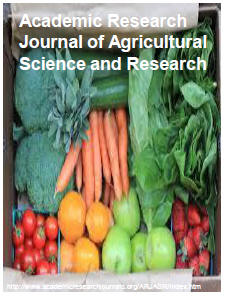| ARJASR |
Academic Research Journal of
Agricultural Science and Research |
||||||||||||||||||||||
|
Academic Research Journal of Agricultural Science and Research Vol. 3(2), pp. 13-20. February, 2015. ISSN: 2360-7874 DOI: 10.14662/ARJASR2014.035
Full Length Research Response of Broiler Chickens fed Diets Containing Differently Processed Sesame (Sesame indicum L.) Seed Meal
1Olaiya, O. David and 2Makinde, O. John
1National Veterinary Research Institute (NVRI) Vom, Plateau State, Jos. 2Department of Animal Production Technology, Federal College of Wildlife Management, New Bussa, Niger State. Corresponding Author’s E-mail: johyinmak@yahoo.com. Tel +2348038365322
Accepted 7 January 2015
This study
was carried out to determine the growth performance and carcass
characteristics of broilers fed diets containing differently processed
sesame seed meal (SSM). Five experimental diets were formulated with
diet 1 (control) containing 0% SSM, while diets 2 to 5 contained
sundried (Su), roasted (Ro), boiled (Bo) and soaked (So) sesame seed
meal each at 15% inclusion level respectively. One hundred and eighty
(180) one day-old broiler chicks average 42.15g sourced from a
commercial hatchery were allocated into 5 treatments of 12 birds in 3
replicates in a completely randomised design and dietary treatment
lasting 56 days. Roasting and soaking significantly (P<0.05) reduced the
anti-nutritional factors in sesame seed meal better than sun drying and
boiling. Final body weight, average weight gain and average daily weight
gain were significantly different (P<0.05) among the treatments.
Control, Ro, Bo and So showed better utilisation of feed than Su. Total
feed consumption and average daily feed intake were significantly
(P<0.05) higher among birds fed So. There were significant (P<0.05)
differences among carcass parameters and organs weight measured between
the control diet and other treatments. It can be concluded that roasting
and soaking were adequate to remove toxic phytochemicals in sesame seed
meal to tolerable levels for broiler diets and inclusion up to 15% of Ro
and So is recommended. At these levels, growth and carcass
characteristics were not significantly affected compared to the control
diet.
How to
cite this article: Olaiya OD, Makinde J (2015). Response of Broiler
Chickens fed Diets Containing Differently Processed Sesame (Sesame
indicum L.) Seed Meal. Acad. Res. J. Agri. Sci. Res.
3(2):13-20.
|
|
|||||||||||||||||||||
